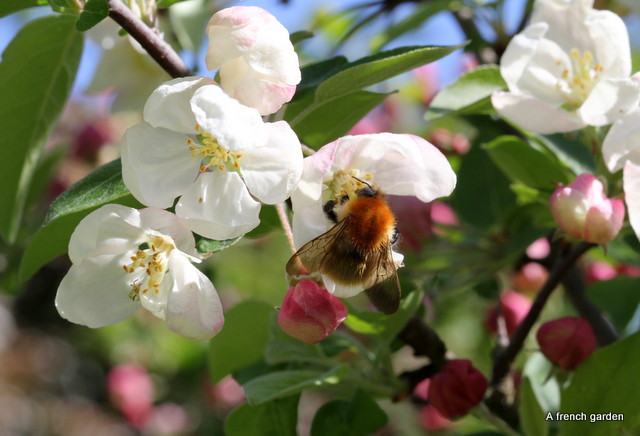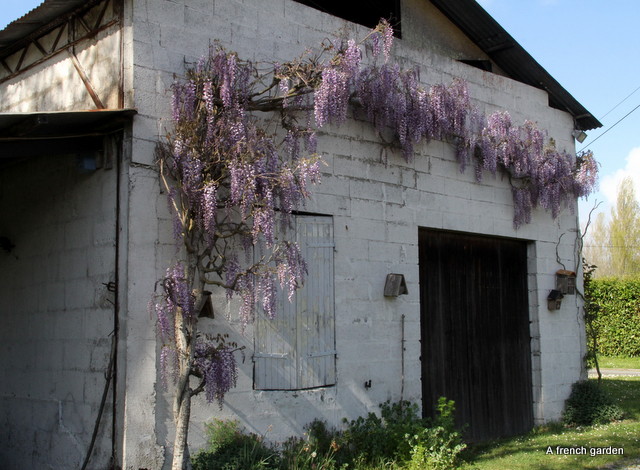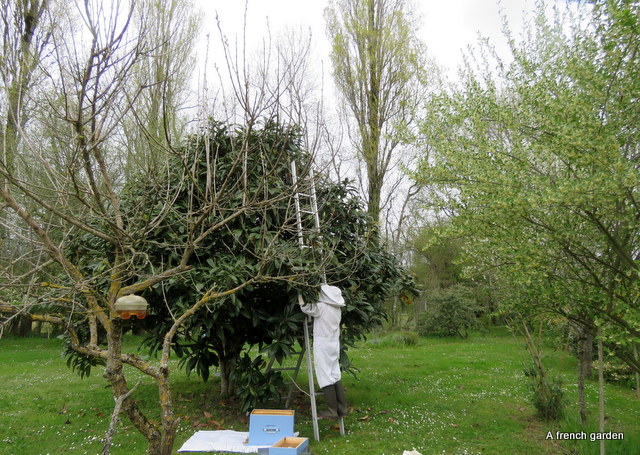
There are more comings at this time of year and it was comforting to see a pair of Hoopoes outside the kitchen window. I always associate them with the summer and we are still definitely in spring with the changeable days, but there are more warm days now.

The Osmia cornuta are finishing their life’s work, and as their colour fades I know I will not be seeing them for much longer.

The bees have no more flowers to go to on the “Accolade” flowering cherry, the recent high winds scattered the petals forming a natural confetti around it.

We have a flowering Malus which is now the place to go to see the bees. The Malus is in the foreground of the picture above but it does not do justice to the colours of the little tree.

The buds are a vivid pink and the colour of the flowers lighten into white as they open.

They provide everything the bees are looking for at the moment.

This is a carder bmblebee, the flowers attract all sorts of bees.

I also think the flowers provide a beautiful backdrop for bee photographs and the short height of the plant makes it more convenient for me. I would say this is a male Eucera longicornis, he has elegant long antenna, but I am no expert.

I think I have made a poor choice in the placement of these allium cameleon. I followed the spacing of the bulbs that was suggested but perhaps they were intended to be grown in the ground? Although I think they would get lost in my garden. Perhaps I just have to wait until next year and they will thicken up? Any ideas?

My Lonicera tatarica is in flower at the moment. This is one of my bush honeysuckles that I bought for the bees but it does not attract the bees like my Malus. However, it provides loads of colour, is drought tolerant and I have been able to grow several more from cuttings.

My Wisteria is coming into flower. The plant against the outbuilding is sheltered and is always the first to flower.

The first swarm arrived on the 11 April. It decided to settle on the top of the Loquat (Eriobotrya japonica) tree. We have never had a swarm settle there and we hope to cut down the top branches to dissuade others to do the same. I was happy to let it fly but Kourosh insisted on climbing up to secure it.

All went well and they are installed at the bottom of the garden.

It is always interesting to get an update from your garden Amelia. I would love to see Hoopoes here, as I think I heard one once – you are so lucky to have them visit. I am still waiting for the the House Martins but am betting they will be here this coming week as we have some warmer weather forecast.
LikeLiked by 1 person
We used to get swallows here when we first came here. Everyone bemoans the lack of swallows and House Martins that used to be so common around here. It is generally agreed that the insects that they fed on have disappeared. We are seeing more and more fields turned into vineyards and the woods which used to separate the fields are being cleared. This provides huge fields with easy access for machinery. Amelia
LikeLike
That is terrible. We are so lucky here. Although we are surrounded by farming land there are lots of small wooded areas in between fields and huge areas of forest not far from here. The farmhouses and barns are ideal nesting spots and there are plenty of insects. We have crickets and grasshoppers galore and it is fun watching the birds wrestle with the bigger ones sometimes!
LikeLiked by 1 person
I think some parts of Europe are much more sensitive to the problems of the environment than others. I do not think France is high on the sensitivity list.
LikeLiked by 1 person
So lovely!
LikeLiked by 1 person
Thank you Arthur. It is such a beautiful time in the garden just now. Amelia
LikeLiked by 1 person
Lovely to see the hoopoes, they are occasionally spotted in Devon but I have never seen one. We had a proper spring day today and the Osmia bicornis finally emerged, a wonderful sight. I would agree that the bee with the long antennae is Eucera longicornis.
LikeLiked by 1 person
Thank you for the confirmation for the Eucera :). Devon seems to have a climate not too different from ours, you always take advantage of it. Amelia
LikeLike
Oh, my! A preview of Spring, and a swarm retrieval all in one post. Our Spring will follow soon, and then I won’t be so jealous.
LikeLike
I felt our spring was long in coming this year too. Amelia
LikeLiked by 1 person
Amelia, this link is more for Kourosh… it just popped up in my Facebook feed and I am sharing it with known beekeeper friends…
It would appear to be a larger version of the grid you described in an earlier year [pre-Covid] and is designed to keep the Asian Hornets well away from the hive… allowing a faster run in for the bees
https://www.facebook.com/photo/?fbid=3322180691426743&set=a.1376485252662973
It comes up as the post itself.
Cheers, Tim
LikeLiked by 1 person
Thank you for that, Tim. We are always looking for ideas to limit the predation by the hornets. We have found that the early spring trapping of the gynes has diminished the attacks and keeping only strong colonies of bees. It depends so much on the weather too. My hope lies with commercialisation of specific pheromone traps but things move so slowly. Ameli
LikeLike
That’s a gorgeous honeysuckle. And I love how you paint your bee boxes. Nice that K was able to save that swarm! Hope all is well for you! -lisa
LikeLiked by 1 person